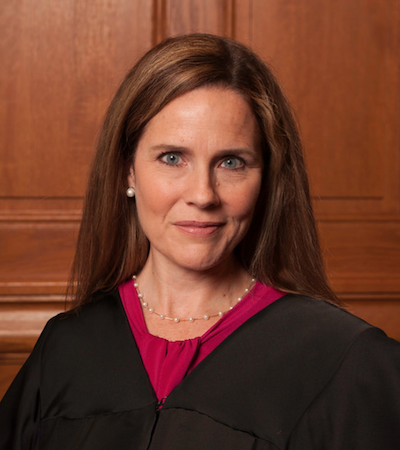Barrett appears confident in her first oral arguments in the Supreme Court

Justice Amy Coney Barrett in 2018. Photo from Wikimedia Commons.
Justice Amy Coney Barrett took part in her first oral arguments in the U.S. Supreme Court on Monday in cases involving the Freedom of Information Act and the federal railroad retirement laws.
Barrett asked about a dozen questions in the two cases, Law.com reports. According to the Washington Post, Barrett “sounded confident and well-versed in the details of the technical cases before the court.” The New York Times focused on Barrett’s questions in the FOIA case, saying Barrett asked “assured and probing questions.”
Comparisons with other justices appointed by President Donald Trump are difficult because the arguments Monday were by telephone, NPR reports. During telephone arguments, each justice speaks in order of seniority, and the time allotted is short. According to Law.com, the justices don’t interrupt each other in telephone arguments “and even humorous moments seem absent.”
During Justice Neil M. Gorsuch’s first Supreme Court argument in 2017, he “asked 22 questions, a half-dozen in a row, about 10 minutes into his first argument,” NPR reports. In 2018, Justice Brett M. Kavanaugh “was more reticent, waiting 20 minutes into his first argument before speaking,” according to NPR. Gorsuch’s 22 questions were more than any current justice asked during their first arguments, according to Law.com.
In the FOIA case, the Sierra Club is seeking documents related to a proposed regulation on cooling water intake structures, according to the New York Times. The Environmental Protection Agency, which proposed the regulation, had to seek input on whether the regulation would harm aquatic life from two other government agencies—the U.S. Fish and Wildlife Service and the National Marine Fisheries Service.
Barrett asked the lawyer representing the federal government how judges should respond when they suspect that documents were marked as drafts to avoid disclosure.
“What other factors would a court consider?” she asked.
The government lawyer, Matthew Guarnieri, responded by listing “peripheral considerations” that a court could consider, according to the New York Times.
Barrett suggested that would be “a pretty fact-intensive determination” and suggested a simpler test.
“So it’s not your position that we should adopt some sort of bright line saying, listen, it’s not over until it’s over, it’s not until it’s actually issued in the sense of being final?” she asked.
According to the New York Times, Guarnieri “was happy to agree to a bright-line rule.”
The Washington Post emphasized the technical nature of the railroad case when it listed part of Barrett’s first question in that argument.
“So, in thinking about the 231g question and whether the denial of a motion to reopen determines rights or liabilities, I think when you look at 261.2 … ,” she began.
Barrett was a law professor at the University of Notre Dame Law School and a judge on the 7th U.S. Circuit Court of Appeals at Chicago before joining the Supreme Court. She was also previously a clerk to the late Justice Antonin Scalia.
The two cases before the Supreme Court on Monday were U.S. Fish and Wildlife Service v. Sierra Club and Salinas v. U.S. Railroad Retirement Board.
Write a letter to the editor, share a story tip or update, or report an error.


